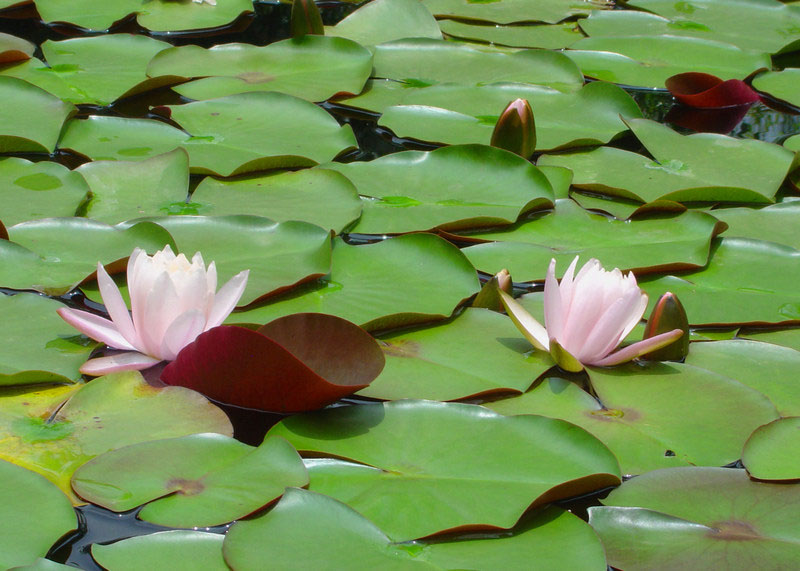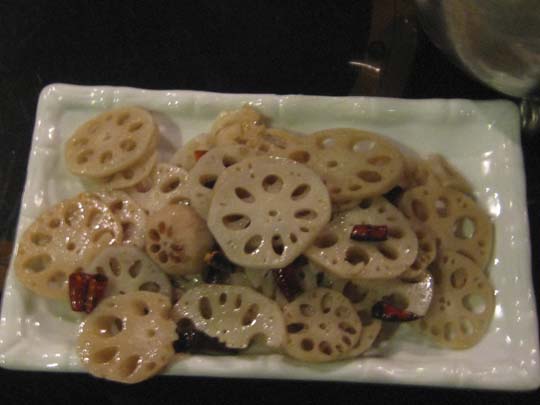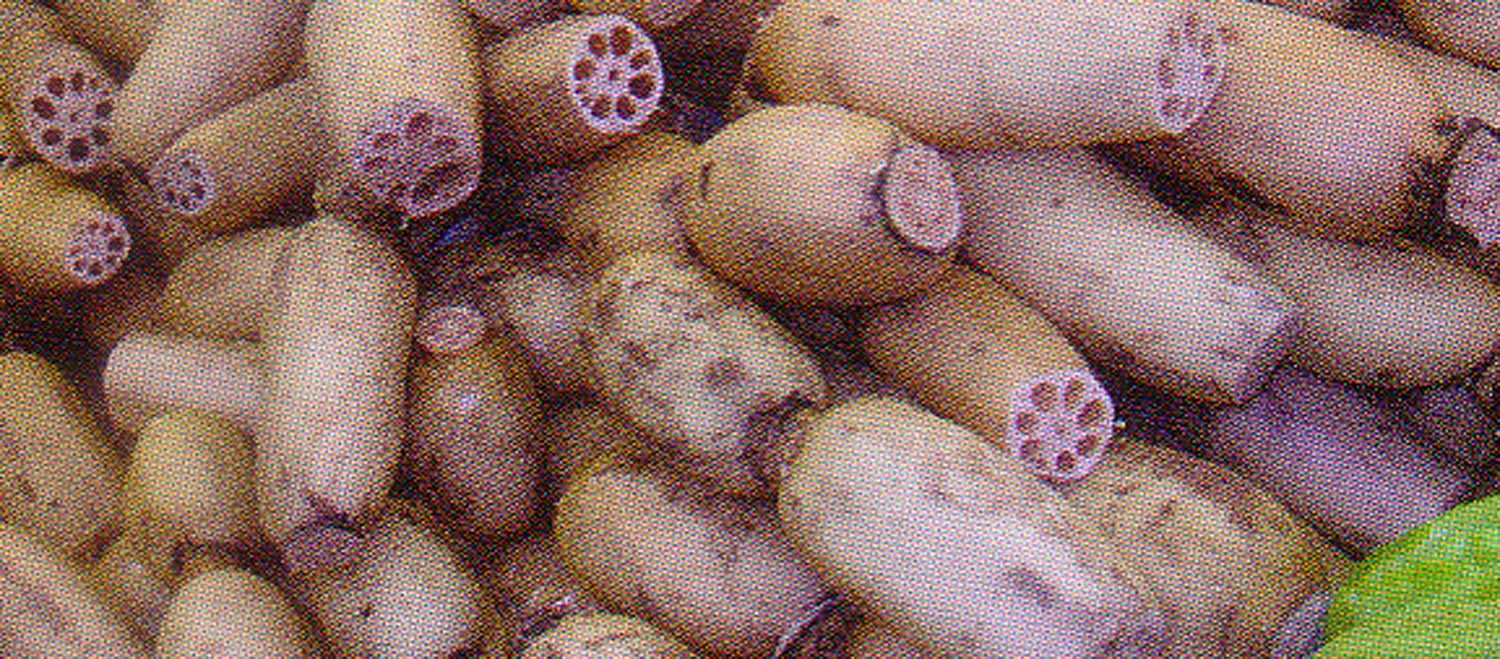
| What is Flavor and Fortune? |
| How do I subscribe? |
| How do I get past issues? |
| How do I advertise? |
| How do I contact the editor? |
Read 13012414 times
Connect me to:
| Home |
| Articles |
| Book reviews |
| Letters to the Editor |
| Newmans News and Notes |
| Recipes |
| Restaurant reviews |
| Article Index (all years, slow) |
| List of Article Years |
| Article Index (2025) |
| Article Index (last 2 years) |
| Things others say |
| Related Links |
| Log In... |
| Authors |
| Categories & Topics |
Lotus: Sacred, Special, and Symbolic
| by Jacqueline M. Newman |
Unusual Ingredients
Spring Volume: 2014 Issue: 21(1) page(s): 31 - 34
 This ancient aquatic perennial is adored by southern Chinese as a beautiful ornamental. In addition, for many it is a religious symbol often seen and revered on tombs; this is nothing new as it has been for thousands of years standing for peace and harmony. This beauty is in the Nymphaeacea family and botanically known as Nelumba nucifera. In Chinese they usually call it lian, some might call it fu rong meaning cotton rose hibiscus.
This ancient aquatic perennial is adored by southern Chinese as a beautiful ornamental. In addition, for many it is a religious symbol often seen and revered on tombs; this is nothing new as it has been for thousands of years standing for peace and harmony. This beauty is in the Nymphaeacea family and botanically known as Nelumba nucifera. In Chinese they usually call it lian, some might call it fu rong meaning cotton rose hibiscus.
The Chinese regard this floral as the supreme flower of summer and believe it is under the influence of Buddhism. They also know it symbolizes the birth of male offspring. Chinese poets have praised its beauty before, during, and after they see them rise three to six feet above the muddy bottom where their lives begin.
Poets often mention the lotus in verse, and artists show them off in paintings and sculpture. Writers tout this plant in many kinds of stories; one specific hedonistic novel from the latter half of the sixteenth century called Chin Ping Mei, uses the food by this name as imagery and counterpoint to sex. In this story, Golden Lotus is the master's concubine who feasts with him and dallies with him in the garden. They drink wine in golden cups shaped like a lotus and they express their intimate desires and indulgences with each other.

 In China, people make use of every part of the lotus plant for food and medicine. Here you see it sliced and the rhizomes in a pile. They use these, the seeds, seed pods, stamens, bulbous rhizomes, silky fibers, leaves, petals, and other parts of its flowers and stems.
In China, people make use of every part of the lotus plant for food and medicine. Here you see it sliced and the rhizomes in a pile. They use these, the seeds, seed pods, stamens, bulbous rhizomes, silky fibers, leaves, petals, and other parts of its flowers and stems.
Some call the under-water parts roots, but that is incorrect as these bulbous segments are actually rhizomes. They, the joints between them, and all parts of this plant are eaten and used medicinally.
One popular medicinal use is when mixed with donkey hide gelatin, apricot kernels, and/or licorice root, among other things. Some use particular lotus parts to combat depression, others still other parts to calm fevers, cool the blood, clear blood poisoning, invigorate the spleen, calm the stomach or the throat, reduce vomiting, and calm inflamed lungs. Stems and seeds and all parts already mentioned are used for food and for traditional Chinese medicine be they wild or cultivated.
Lotus flower petals, when dipped in yolk paste and deep fried, curl up. They are delicious, delicate, and distinctive. They can be stuffed with grains and/or seafood, eaten and enjoyed that way. Other gastronomic appreciation includes the underwater bulbous sections prepared in any number of ways. It does help to know they are starchier than the seeds, and can be used as staple foods.
The country's early rulers did use the seeds, seed pods, rhizomes, and the flowers as offerings at temples; they consecrated them to their ancestors. They know and you should too, that the lotus is the sacred flower of Buddhism, the symbol of purity and perfection. This member of the water lily family does grow in big bowls in most temple courtyards. They show off their long stalks in their centers, their leaves look like umbrellas, their flowers the most beautiful of many other florals. The lotus is cultivated for its beauty and for food for monks and ordinary folk. Buddhists adore this plant for all of the above uses, and they believe the opening of the white flowers and closing of the blue ones determine day and night in heaven. They see Buddha sitting on a sacred lotus, his priests often assume the lotus position when seeking quiet and total distraction from the world around them. They pray to Buddha often and believe he was born in this world and now lives above it. Taoists see the lotus as their emblem of fertility and one of their eight immortals holding a lotus stem with a seed pod on it. Lamists see this plant as a symbol of passivity.
Chinese, Buddhists or not, eat every part of the lotus be it seeds, stems, flowers, etc. if fresh, dried, or frozen. Besides using it for food and medicine, they use its large leaves to wrap foods before steaming them, to wrap packages, in Eight Treasured Rice, and as a golden paste for stuffing buns, dumplings, etc. Starch made from its dried stems, seed pods, and the underwater bulbous segments make extra-crispy coatings for fried foods. Seeds used in soups at a wedding wishes the couple successive sons. Rhizome sections represent strength in a man's arm and shows the world who rules the roost.
Immature seeds are eaten as if they are nuts, Chinese considering them nourishing and health giving. The rhizomes can be boiled, baked, fried, or candied, their holes stuffed with sweets, meats, and/or starchy mixtures. Said to be good food for the elderly, the lotus is considered yin, the starchy parts delicate in taste, and good for heart-related ailments.
Starch from the rhizomes, when ground, can be called 'lotus arrowroot' but for reasons we know not, why. We do know all forms of the lotus are somewhat sweet, aromatic, and filling. Sometimes the starch is mixed with potato or another starch and used as a thickener in various dishes, bakery products included.
Traditional medicinal practitioners use parts of one or more of the hundred or more species of lotus for assorted remedies alone or with onions, dates, pomegranates, caraway and/or poppy seeds, castor oil, elderberries, mint, and other items. They are used to improve the internal workings of the body. These practitioners say they contribute to longevity.
The wife of the First Marquis of Tai who died a few years after 168 BCE, was found in Han Tomb #1 buried with lotus seeds. This early reference is not the earliest one for this plant, before it there was one in 312 BCE inscribed on a bamboo slip with information about two common kengs or stews made with lotus, one using sturgeon, the other carp. Others slips mention lotus seed paste to stop bleeding and to break up congealed blood. One indicates the seeds can be a symbol of offerings. One historian says they may mean 'past, present, and future.' Still another says they mean progeny and steadfastness in family, and strength and good health, improved circulation, and increased virility. These days, Chinese eat lotus at weddings and if broken in half say the gum-like threads in them will bind the couple together, or mean that nothing can break them apart. For those wanting to know more about this plant, we recommend visiting the Sanshi District of Fushan City in the Guangdong Province. There three hundred varieties grow in a local park. And while there,learn more about the lotus, eat a lotus banquet, hear songs and see dances featuring the lotus, also learn many folk customs about this plant. Fushan City is three hours from Hong Kong reachable by train or bus, even stay in a Holiday Inn appropriately called the Lotus Holiday and from its windows see those many lotus plants growing in ponds. They were planted one spring and buried in shallow water about seven inches below the surface. Their leaves did emerge from new nodes, each section smaller than the one before, the flowers emerge in late summer just before harvesting.
As to the seed pods, after harvesting them, the nuts are removed and can be brewed as tea or boiled and eaten that way as one does nuts. At this park one learns the rhizomes are used as cosmetics, the vegetables prepared plain or stuffed, or dried and ground into flour, or roasted and then ground and used as a starch that does not thicken as well any non-roasted starch.
We like chips made from the rhizomes, that recipe is below, and do know they can be frozen and will stay that way some four to six weeks. But that is not so in most houses as they are consumed soon after coming out of fresh oil where they were fried for just four minutes or so.
We did learn at this park that circles of lotus can also bet pickled in a sweet Chinese vinegar and served as an appetizer. We have been told that dried lotus seeds should be reconstituted then simmered for half an hour or more before using them in soup or any stir-fried dish, or softened, mashed, mixed with sugar, a little oil, and some seasonings such as cinnamon and/or orange or tangerine peel. These techniques makes them good for buns, snacks and/or dim sum.
Below are some recipes worth preparing. We suggest you learn, as many Chinese and other Asians have, that this food is worth knowing about when made into fritters, sliced and fried, mashed and used as a paste, in vegetable dishes or dim sum, and in many other ways. Do enjoy them in any of the recipes below and make up some yourself.
lotus chips Ingredients: 1 pound lotus rhizomes, peeled, sliced thin and dried an hour in a low oven 4 cups fresh vegetable oil Preparation: 1. Heat a wok or deep fry pan, add the oil and just before it smokes, add one to two cups of the lotus slices. 2. Stir the slices while frying, and remove them when golden. Drain in a single layer on paper towels. 3. Repeat until all are fried. When cool eat, or pack in plastic containers. Freeze if desired. They do not need defrosting before serving as they are good when very cold.
Lotus seed soup Ingredients: 10 to 20 fresh lotus seeds, dark tips removed and discarded, and simmered for half an hour or until soft 4 large dried Chinese black mushrooms, soaked in warm water until soft, stems then discarded 4 shrimp, peeled, vein removed and discarded, and slivered 1/4 cup chicken thigh meat, slivered 2 tablespoons Jinghua or Smithfield ham, slivered 4 to 6 cups chicken broth 3 Tablespoons lotus root starch 2 slices fresh ginger, peeled and slivered 2 tablespoons Chinese rice wine 1 teaspoon salt 2 teaspoon granulated sugar 2 cup Chinese celery, cut in one to two inch pieces than slivered the long way 1/4 cup cilantro, coarsely minced Preparation: 1. Put all ingredients except the celery and the cilantro into a large pot and bring to just below the boil. Make sure the lotus starch, if lumpy, is stirred in carefully until all lumps are mashed and it is without a single lump. Now simmer for half an hour or more until the lotus seeds are soft. 2. When all lumps are removed, add the celery and the coriander and bring to a quick boil for just one minute. Then pour the soup into a pre-heated sand pot or large tureen, and serve.
COLD SLICED LOTUS DISKS Ingredients: 4 segments of fresh lotus, peled and sliced into one-quarter-inch circles 1/4 cup Chinese rice vinegar 3 Tablespoons granulated sugar 1 teaspoon coarse salt 1 teaspoon hot spicy oil 2 sprigs fresh coriander, minced Preparation: 1. Marinate lotus disks in vinegar, sugar, salt, and spicy oil for two hours, then drain and set aside. 2. Add coriander and serve.
Stuffed steamed rice in lotus leaf Ingredients: 3 dried lotus leaves, soaked for half an hour 3 cups cooked glutinous rice 1 boneless skinless chicken thigh, diced into half-inch pieces 2 Tablespoons lard or rendered pork or chicken fat 2 Chinese black mushrooms, soaked in warm water for half an hour, stems removed and discarded, diced into half-inch pieces 2 cup canned winter bamboo shoots, cut into half-inch cubes 1 Tablespoon vegetable oil 3 slices fresh ginger, peeled and diced 2 cloves garlic, peeled and smashed 2 Tablespoons Chinese rice wine 2 tablespoons chicken stock 2 Tablespoons thin soy sauce 1 Tablespoon oyster or a hot sauce 1 tablespoon cornstarch mixed with a like amount of cold water some string Preparation: 1. Drain and dry the lotus leaves and cut away any thick steams, then lay them out in an overlapping fashion or use them one by one. 2. Spread the rice on the leaves leaving one inch around the outside of the large one or the three smaller ones with no rice. 3. In a bowl, mix the chicken, lard, mushrooms, and the bamboo shoots. 4. Heat the oil, fry the ginger and the garlic for one minute, then add the rice wine, stock, soy sauce, oyster or other sauce, and the cornstarch mixed with cold water; then add the chicken mixture. Spread this onto the rice, roll up, and tie is several places. 5. Prepare a steamer and put the rice roll or rolls on a steamer basket after the water comes to the boil. Then steam for one hour if one large roll, forty minutes if three smaller ones. Serve the rolls on a platter, cutting the large one into four or more pieces, the smaller ones in two or three, and serve.
Deep-fried lotus slices Ingredients: 2 pound ground pork 2 eggs, separated 2 cups all purpose flour 1 teaspoon salt 1 pound fresh lotus, peeled and sliced crosswise into quarter-inch thick circles 1 cup vegetable oil 1 Tablespoon soy sauce 1 scallion, slivered 1 teaspoon fresh ginger, peeled and slivered 1 cup dipping sauce of your choice, spicy or not Preparation; 1. In a small bowl, mix pork and one egg white and set aside. 2. Make a batter with the other egg white and both yolks, add the flour, salt, and two tablespoons of cold water, and stir until it is a lump-free batter. 3. Take one slice of lotus, but about a tablespoon of the pork mixture on it and top with another slice of lotus, and set all the sandwiches aside. 4. Heat oil almost until it smokes, dip one lotus sandwich in the batter, allow excess to drip off, and add to the hot oil. Add a few more sandwiches in the oil and deep fry them until golden brown, then remove and drain them on paper towels. Repeat until all are fried and golden. Serve with scallion slivers and a dipping sauce of your choice.
Stir-fried Lotus, shrimp, and mushroom pancakes Ingredients: 2 pound lotus sections, peeled and shredded 2 teaspoon coarse salt 2 teaspoon granulated sugar 1 teaspoon thin soy sauce 2 Tablespoons cornstarch 2 Tablespoons dried shrimp, soaked for one hour in warm water, then squeeze water out and discard it 2 large Chinese black mushrooms, soaked, stems removed and slivered 1cup ground pork 2 Tablespoon mushroom soy sauce 2 Tablespoons cornstarch 1 scallion, slivered 2 Tablespoons vegetable oil 1 scallion, cut into one-inch slivers 1/4 cup vegetable oil Preparation: 1. Mix shredded lotus with salt, sugar, soy sauce, cornstarch, dried shrimp, mushrooms, ground pork, mushroom soy sauce, and the ground pork, and make into two inch patties. 2. Heat oil and fry these patties on both sides until golden brown. Then drain on paper towels, and serve.
Lotus slices in honey Ingredients: 2 segments of fresh lotus, peeled and cut into one-quarter-inch thick circles that have been steamed for half an hour, then removed from the steamer and put on a platter 2 cup cooked glutinous rice, cooked and cooled 2 Tablespoons honey 1 Tablespoon minced preserved apple, minced 1 Tablespoon preserved pear, minced 2 Tablespoons preserved tangerine peel 1 teaspoon sugar Preparation: 1 Mix rice and preserved minced fruit pieces. Mix rice, honey, and preserved fruits and stuff the lotus circle holes with the rice mixture and the sugar. 2. Put rice-stuffed circle on clean dish towel on a steam-proof platter and steam over rapidly boiling water for half an hour. 3. Serve the platter leaving any syrup formed on it with small forks or toothpicks for eating the stuffed lotus circles.

Copyright © 1994-2025 by ISACC, all rights reserved
Address
3 Jefferson Ferry Drive
S. Setauket NY 11720